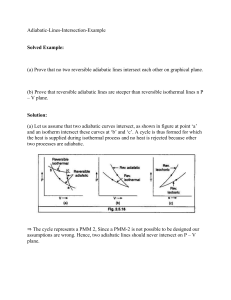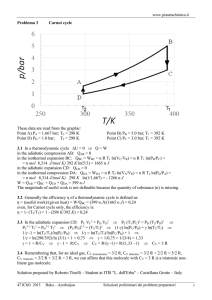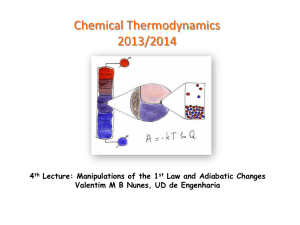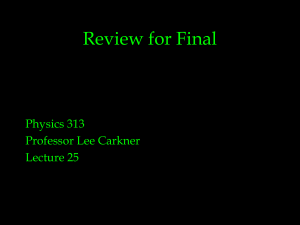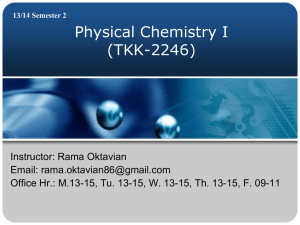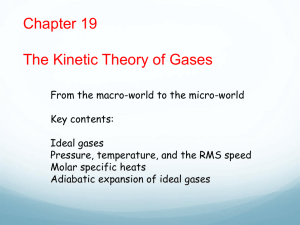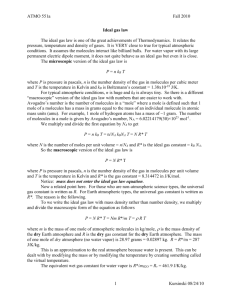Chapter 15 Thermodynamics of gases - E
advertisement
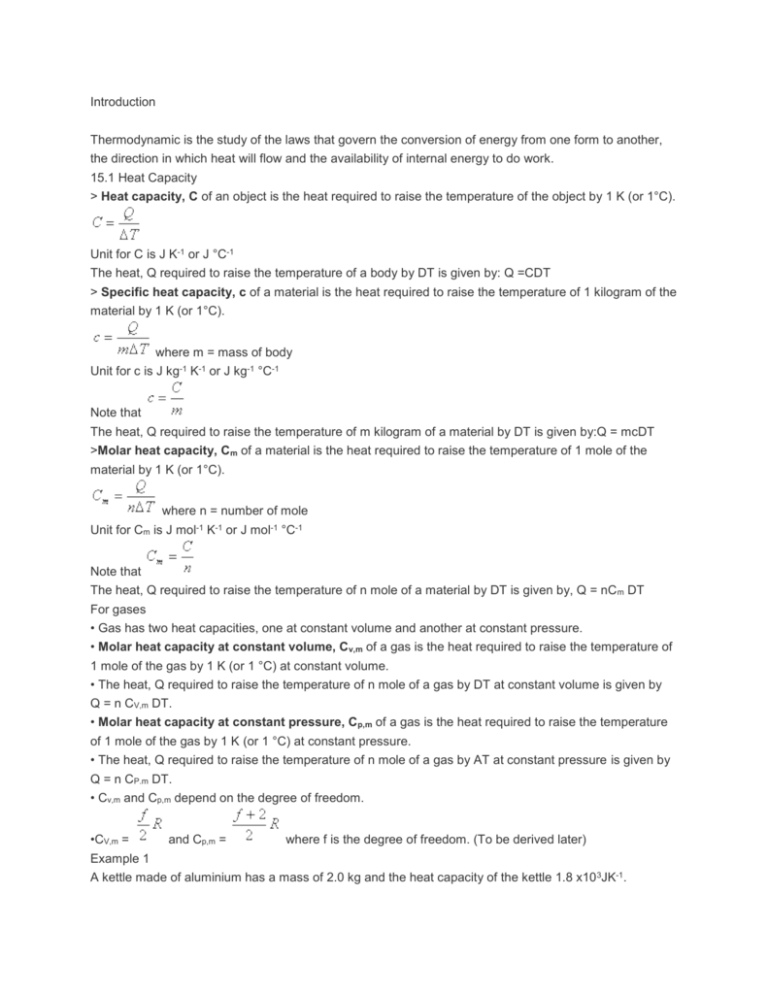
Introduction Thermodynamic is the study of the laws that govern the conversion of energy from one form to another, the direction in which heat will flow and the availability of internal energy to do work. 15.1 Heat Capacity > Heat capacity, C of an object is the heat required to raise the temperature of the object by 1 K (or 1°C). Unit for C is J K-1 or J °C-1 The heat, Q required to raise the temperature of a body by DT is given by: Q =CDT > Specific heat capacity, c of a material is the heat required to raise the temperature of 1 kilogram of the material by 1 K (or 1°C). where m = mass of body Unit for c is J kg-1 K-1 or J kg-1 °C-1 Note that The heat, Q required to raise the temperature of m kilogram of a material by DT is given by:Q = mcDT >Molar heat capacity, Cm of a material is the heat required to raise the temperature of 1 mole of the material by 1 K (or 1°C). where n = number of mole Unit for Cm is J mol-1 K-1 or J mol-1 °C-1 Note that The heat, Q required to raise the temperature of n mole of a material by DT is given by, Q = nC m DT For gases • Gas has two heat capacities, one at constant volume and another at constant pressure. • Molar heat capacity at constant volume, Cv,m of a gas is the heat required to raise the temperature of 1 mole of the gas by 1 K (or 1 °C) at constant volume. • The heat, Q required to raise the temperature of n mole of a gas by DT at constant volume is given by Q = n CV,m DT. • Molar heat capacity at constant pressure, Cp,m of a gas is the heat required to raise the temperature of 1 mole of the gas by 1 K (or 1 °C) at constant pressure. • The heat, Q required to raise the temperature of n mole of a gas by AT at constant pressure is given by Q = n CP.m DT. • Cv,m and Cp,m depend on the degree of freedom. •CV,m = and Cp,m = where f is the degree of freedom. (To be derived later) Example 1 A kettle made of aluminium has a mass of 2.0 kg and the heat capacity of the kettle 1.8 x10 3JK-1. (a) What is the heat required to increase the temperature of the kettle by 40°C? (b) What is the specific heat capacity of aluminium? Solution Example 2 How much heat is released when 2.5 kg of water is cooled from 90°C to 30°C? [specific heat capacity of water is 4.2 x 103 J kg-1 K-1] Solution Example 3 The specific heat capacity of copper is 385 J kg-1 K-1. The molar mass of copper is 63.5 g. What is the molar heat capacity of copper? Solution 15.2 Work > When a gas expands, work is done by the gas. When a gas is compressed, work is done on the gas. > When the gas at constant pressure expends by pushing a light frictionless piston as shown in Figure above the work done by the gas is: dW = F dx = pA dx = p dV > Hence, the work done by a gas when its volume increase from V1 to V2 is given by = = area under the p-V graph > The work done by gas for various types of changes will be discussed in the subsequent section. The changes involved are: - Isobaric change (constant pressure) - Isometric change (constant volume) - Isothermal change (constant temperature) - Adiabatic change (no heat flow in or flow out from the system) Example 4 A gas undergoes the cycle of pressure and volume changes W ® X ® Y® Z ® W as shown in the diagram. What is the net work done by the gas? Solution 15.3 First Law of Thermodynamics > The first law of thermodynamics is a law of conservation of energy. > The first law of thermodynamics states that the heat supplied to a system equals to the sum of increase in internal energy of the system and the work done by the system. Q= DU+W > The sign convention for Q, DU and W used in the formula above is shown below: Q is positive when heat is supplied to the system. Q is negative when heat is released from the system. DU is positive when the internal energy (temperature) increases. DU is negative when the internal energy (temperature) decreases. W is positive when work is done by the system. W is negative when work is done on the system. 15.4 Internal Energy > The internal energy, U of a system is the total potential and kinetic energy of the molecules. > For an ideal gas, because the force between the molecules is negligible, the potential energy equal zero. The internal energy is the total kinetic energy of the molecules only. > From chapter 14, for gas with f degree of freedom, kinetic energy (internal energy) for one mole of gas = kinetic energy (internal energy) for n mole of gas = (n) > The internal energy of the ideal gas depends on: (a)Amount of gas (number of moles) (b)Absolute temperature (c) Degree of freedom > When temperature of gas increases, internal energy increases and DU is positive. When temperature of gas decreases, internal energy decreases and DU is negative. Example 5 A fixed mass of gas undergoes changes in pressure and volume as shown in Figure above. When the gas is taken from state P to state R by the stages PQ and QR, 16 J of heat are absorbed by it and 6 J of work are done by it. When the same resultant change is achieved by stages PS and SR, 2 J of work is done by the gas. (a) What is the change in internal energy from state P to state R? (b) What is the heat absorbed by the gas when the gas undergoes the changes by stages PS and I SR? Solution 15.5 Isometric Change > An isometric process (short term for isovolumetric) is a constant-volume process. > Since volume is constant, DV = 0 and W=p DV=0 > Q =DU+W = DU+0 thus Q = DU > To raise the temperature of n mole of gas by DT at constant volume, the heat required Q = nCv,m DT = DU 15.6 Isobaric Change > An isobaric process is a constant-pressure process. > Since there is a change in volume and pressure is constant at p, W=pDV=p(V2-V1) > Q = DU+W = DU+p (V2-V1) >To raise the temperature of n mole of gas by DT at constant pressure, the heat required Q = nCP,M DT= DU + p(V2-V1) 15.7 relation between Cv,m and Cp,m > n Cp,m DT=DU+p(V2-VI) n Cv,m DT = DU n Cp,m DT – n Cv,m DT = p(V2 – V1 ) > From the ideal gas equation pV = nRT pV2 = nRT2 pV1 = nRT1 pV2-pV1 = nRT2 – nRT1 p(V2 – V1) = nR(T2 –T1) = nR DT n Cp,m DT – n Cv,m DT = p(V2 – V1 ) and CP,m – Cvm = R = nR DT Example 6 The molar heat capacity at constant volume of an ideal gas is 20.8 J mol-1 K-1. (a) How much heat is required to raise the temperature of 3.0 mole of the gas from 300 K to 450 K at constant volume? (b) How much heat is required to raise the temperature of 3.0 mole of the gas from 300 K to 450 K at constant pressure? (c) What is the internal energy of the gas at 300 K? (d) What is the increase in internal energy when the temperature changes from 300K to 450K? [R = 8.31 J K-1 mol-1] Solution The ratio of •Internal energy for n mole of gas at temperature T = (n) •Change in internal energy for n mole of gas when there is a temperature change of DT = (n) R DT so DU = nCv,m DT = (n) R DT and CV,m = R Cp,m = CV,m + R = R+ R = R •The ratio of Cp,m to CV,m is denoted by g g= = = Note: CV,m can also be obtained from the definition CV,m = = = = R Values of Cp,m , CV,m and g at a glance Degree of freedom at room temperature CV,m = R Cp,m = CV,m + R = g= = R Monoatomic Diatomic Polyatomic 3 5 6 R R R R =1.67 =1.40 R 4R =1.33 15.8 Isothermal Change > An isothermal process is a constant-temperature process. >Since temperature is constant, DT = 0 and DU = 0 > Q= DU + W =0 + W thus Q=W > An isothermal change obeys Boyle’s law. pV – constant > For an isothermal change, the gas must be held in a thin-walled, highly conducting vessel, surrounded by a constant temperature bath. The change must take place slowly so that heat can flow into the gas or flow out from the gas to maintain its temperature at every instant during the change. Work done in an isothermal change •Work done by gas in an isothermal change is given by W = •Using the ideal gas equation pV = nRT p= so W = = = = = Example 7 One mole of an ideal gas undergoes an isothermal change at a temperature T so that its volume V is doubled. What is the work done by the gas during this change? Solution Example 8 A given mass of air contracts isothermally from a volume of 2.0 x 10-4 m3 and pressure of 1.0 x 105 Pa to a volume of 1.5 x 10-4 m3 at a temperature 300K. (a) How many moles of gas are there? (b) What is the new pressure? (c) What is the work done on the gas? [R = 8.31 J K-1 mol-1] Solution l5.9 Adiabatic Change > An adiabatic process is a process where no heat is transferred into or out of the system. i.e. Q = 0 >Q = DU+W thus 0 = DU + W and W = -DU > During an adiabatic expansion, W is positive and DU is negative. i.e. during adiabatic expansion, internal energy decreases and temperature decreases. >During an adiabatic compression, W is negative and DU is positive. i.e. during adiabatic compression, internal energy increases and temperature increases. > An adiabatic change observes the following equations: pVg = constant TVg-1 = constant > For an adiabatic change, the gas must be held in a thick-walled, badly conducting vessel. The change must take place rapidly so that there is little time for the heat to escape. > The magnitude of gradient of the adiabatic curve is greater than that of the isothermal. Adiabatic equation • Ideal gas equation pV = nRT •First law of thermodynamics Q = DU + W •Adiabatic change Q= 0 and W = -DU •Change in internal energy DU = nCv,m DT •Work done W = pDV •Relation between Cp,m = CV,m + R • From W = -DU pDV = – nCv,m DT DV = – nCv,m DT DV = – Cv,m (Cp,m – CV,m) = – Cv,m =- =(g-1) =- (g-1) =- (g-1) ln V = -ln T + constant ln T + (g-1) ln V = constant ln TVg-1 = constant TVg-1 = constant · From pV = nRT, substitute TVg-1 into the above equation = contant Vg-1 = contant pVg = constant Work done in an adiabatic change • Work done by gas in an adiabatic change is given by: W = • Using the adiabatic equation pVg = constant= k p= so W = = = = = where = [p2V2 –p1V1] = [T2 – T1] where p1V1 = nRT1 and p2V2 = nRT2 Note: Work done for adiabatic change may also be obtained directly from change in internal energy if the temperatures are known. W = -DU = -n CVm DT = -(n) R DT = -(n) R [T2 – T1] Example 9 Some gas, assumed to behave ideally, is contained within a cylinder which is surrounded by insulation to prevent loss of heat. Initially the volume of gas is 2.9 x 10-4 m3, its pressure is 1.04 x 105 Pa and its temperature is 314 K. The gas undergoes adiabatic compression until the volume becomes 2.9 x 10 5 m3 and the temperature becomes 790 K. (a) Calculate g, the ratio of (b) Calculate the pressure of the gas after the compression. (c) What is the work done to compress the gas? Solution Example 10 The gas in a heat pump can be considered to undergo a cycle of changes of pressure, volume and temperature. One such cycle, for an ideal gas, is shown on the graph. The table below shows the changes in internal energy in section A to B, B to C and C to D. 1 also shows that in sections A to B and C to D, no heat is supplied to the gas. Section of Increase in internal Heat supplied Work done cycle energy of gas/J to gas/J by gas/J A to B 1200 0 B to C -1350 C to D -600 D to A 0 Using the first law of thermodynamics and the data from the graph, determine: (i)Work done by gas for A to B. (ii)Work done by gas for C to D. (iii) Work done by gas for B to C. (iv) Heat supplied to gas for B to C. (v)Work done by gas for D to A. (vi) Increase in internal energy for D to A. (vii) Heat supplied to gas for D to A. Solution Example 11 The gas in the cylinder of a diesel engine can be considered to undergo a cycle of changes of pressure, volume and temperature. One such cycle, for an ideal gas, is shown on the graph. (a) The temperature of the gas at P and Q are 300 K and 660 K respectively. Use the data from the graph to find the temperatures at R and S. (b) During each of the four sections of the cycle, changes are being made to the internal energy of the gas. Some of the factors affecting these changes are given in the table below. Section of Heat supplied Work done Increase in internal cycle to gas/J by gas/J energy of gas/J P to Q 0 -300 Q to R 2580 740 R to S 0 440 S to P -1700 Deduce the increase in internal energy of gas for section: (i) From P to Q. (ii) From Q to R. (iii) From R to S. (iv) From S to P. (c) What is the net work output during a complete cycle?

